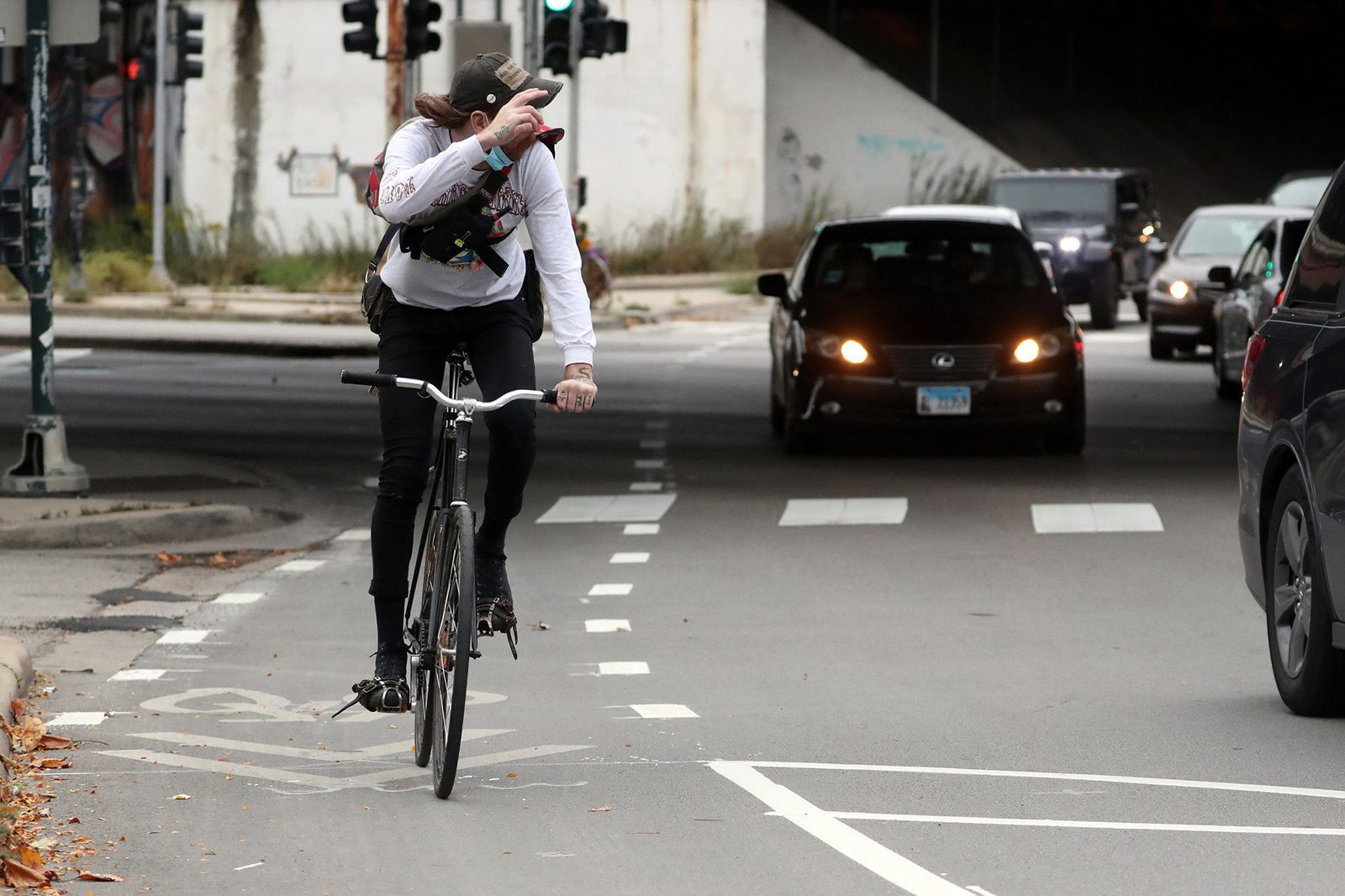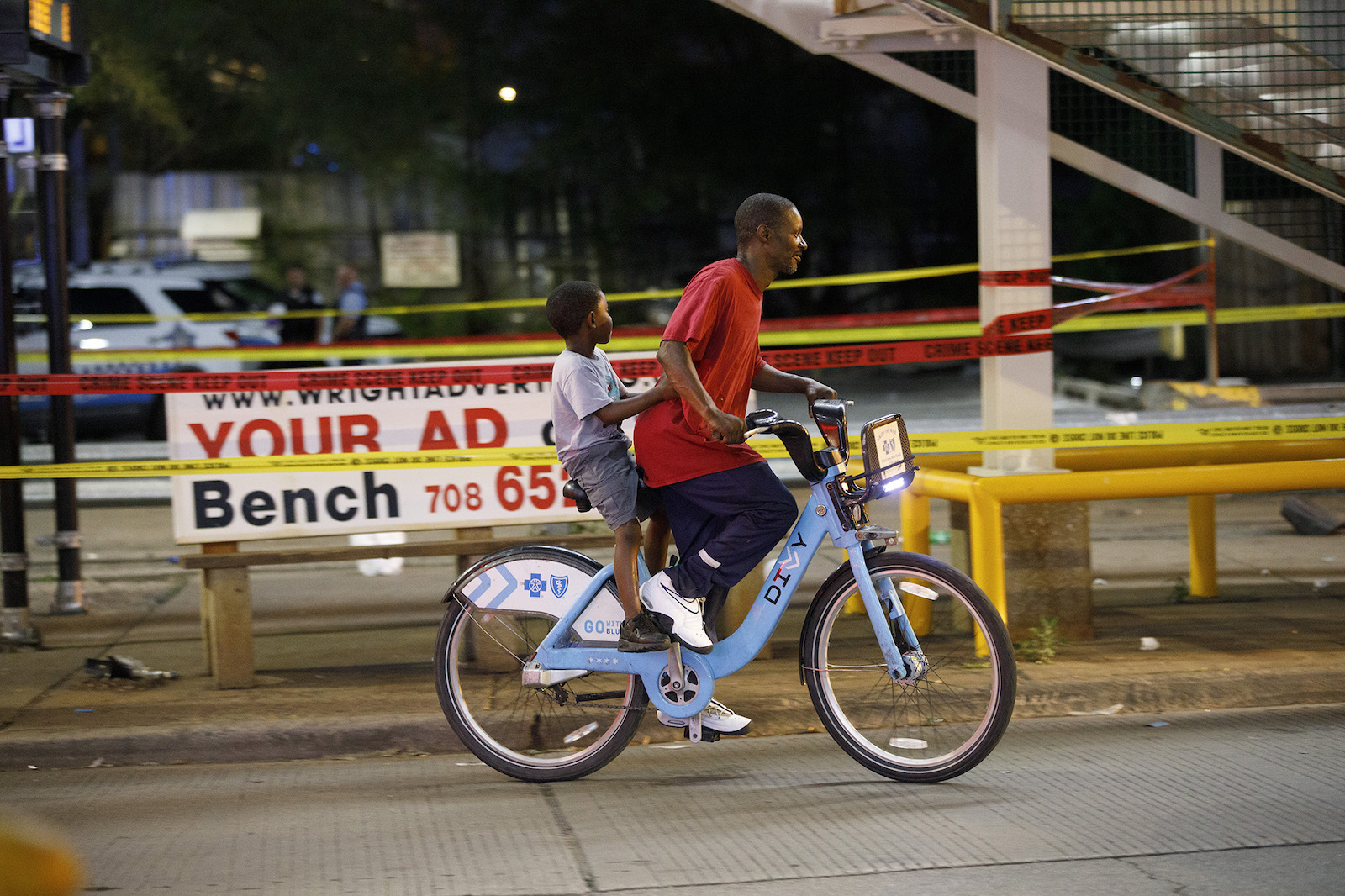In 2017, avid cyclist Johnny Harris received a ticket from the Chicago Police Department for riding on the sidewalk. A year after the incident, the Black cyclist told the Chicago Reader, he briefly dipped onto the sidewalk to avoid potholes while riding on the West Side of Chicago, in between the predominantly Latino neighborhood of Garfield Park and the predominantly Black neighborhood of North Lawndale. The police didn’t care that he was just trying to prevent a crash and tumble at the fault of a crumbling road. He was fined $50 anyway.
Harris’s experience at the time was a norm, part of a larger policing strategy in the city of Chicago called “stop and frisk.” The strategy was used to stop people for petty grievances, such as riding their bike on the sidewalk, in hopes it would lead to bigger arrests such as drug or gun possession.
A Chicago Tribune analysis found that between 2008 and 2016, each of the top ten neighborhoods where cyclists were ticketed at the highest rates were either majority Black or Latino. During that period, bike riders in Black neighborhoods were ticketed twice as much as cyclists in white neighborhoods. But in 2016, shortly after the American Civil Liberties Union, or ACLU, released a report on the practice, the ACLU and the Chicago Police Department, or CPD, reached a settlement agreement to reform the practice of investigatory street stops. In return, ticketing for bike riders across the city declined by 64 percent by the end of 2019.
However, the racial disparities in ticketing only got worse. A new study authored by University of California assistant professor Jesus Barajas has found that from 2017 to 2019, bicyclists riding in Chicago’s Black neighborhoods were eight times more likely to be ticketed by police than those riding in white neighborhoods. More than 90 percent of those tickets were issued for riding on the sidewalk, something that is hard to navigate on the South and West Sides of Chicago where a majority of the city’s communities of color are found. It’s where bike infrastructure — protected bike lanes, well-maintained streets, and painted roads — are sparse, making the climate-friendly mode of transportation life-endangering for more reasons than one.
To Barajas, whose research focuses on mobility justice and transportation equity, Chicago shows how a lack of infrastructure contributes to the over-policing of Black and brown communities, proving a connection between government planning and systemic racism.“If you’re riding on the sidewalk, it’s simple,” he said It’s quite likely because you don’t feel safe on the street.”
The connections between race, policing, and infrastructure illuminate a deeply unjust trend in Chicago — and they have serious implications on the environment. “You can give me any injustice that Black folks are facing and I would trace it back to structural racism,” Oboi Reed, founder of the West Side justice organization Equiticity, told Grist. “In Chicago, Black communities are facing multi-generational sustained disinvestments and it’s impacting every single one of our life and health outcomes.”
The new analysis, which Equicity consulted on, found that on average, Chicago’s white neighborhoods have 50 percent more bike lanes than Black neighborhoods. So, as Black riders, who are less likely to be protected on the streets, move to ride on the sidewalk, their likelihood for a police interaction exponentially increases. The disparities are then intensified when the police arrive. Chicago’s white and Black populations are nearly identical in size at 33 percent and 30 percent respectively, yet 75 percent of the people arrested and jailed in Chicago are Black. White people make up just 7.5 percent of the city’s jail population.
It’s obvious to see then, Barajas says, that “the city’s traffic plan, Vision Zero, contributes to compounding inequities. A lack of infrastructure leads to additional policing in neighborhoods that are already over policed.”
This also means people in Black communities are less likely to be able to openly access their environment — and the city loses its climate-friendly impacts as a result. Riding bicycles increases physical activity, improves mental health, improves air quality, and reduces levels of greenhouse gas emissions. A recent study found that choosing a bike over a car just once a day reduces an average citizen’s carbon emissions from transport by 67 percent.

To make things worse, the study found that the city’s priorities did not even make the streets safer. During the study’s three-year period, bikers in white neighborhoods were 3 times more likely to experience serious or fatal bike crashes. Barajas hypothesizes that this is because white neighborhoods have higher levels of bike traffic, but it also shows enforcement isn’t based on crashes or high numbers of riders.
This, Reed says, is the most poignant evidence against the effectiveness of enforcement. “We are asking enforcement to fix a problem that the transportation and planning sector created,” he said.
Both Reed and Barajas are calling for a holistic approach to tackling the inequities around biking in Chicago. A simple solution they’ve found is adding bike lanes. In Chicago, between 2017 and 2019, 85 percent fewer tickets were given out and crashes declined on streets that had bike lanes. There’s also proof that bike lanes encourage new riders to take the streets. A 2021 study published in the Proceedings of the National Academy of Sciences, found that in cities where bike infrastructure was added, cycling increased up to 48 percent more than in cities that did not add bike lanes.
There’s a way to tackle safety challenges in biking, while also addressing major environmental justice problems in cities like Chicago, they contend. For years, Reed’s Equiticity has worked to build a cycling culture on the city’s West Side through programming and research. Riding a bike, Reeds says, both betters the environment and people’s health.
Barajas’ research, he says, proves that urban infrastructure investments lead to improved living experiences for vulnerable people. “Buildings — we can’t move them — but we can reconfigure the streets,” he said. This includes building protected bike lanes, investing in regular road repairs, and giving commuters incentives to move from gas-guzzling cars to two wheels. Encouraging more people to ride, they say, means both supporting physical and mental health, but also allowing people to better connect with their city.



